Relevance of Traditional Budgeting and Standard Costing in Contemporary Business Accounting
VerifiedAdded on 2023/03/20
|11
|3404
|90
AI Summary
This essay discusses the relevance of traditional budgeting and standard costing in contemporary business accounting. It explores the drawbacks of traditional budgeting and suggests alternatives such as rolling forecasts, accrual method of accounting, and performance budgeting. It also examines the decline of standard costing in the competitive business environment and proposes alternatives like FIFO and LIFO inventory valuation and lean accounting.
Contribute Materials
Your contribution can guide someone’s learning journey. Share your
documents today.
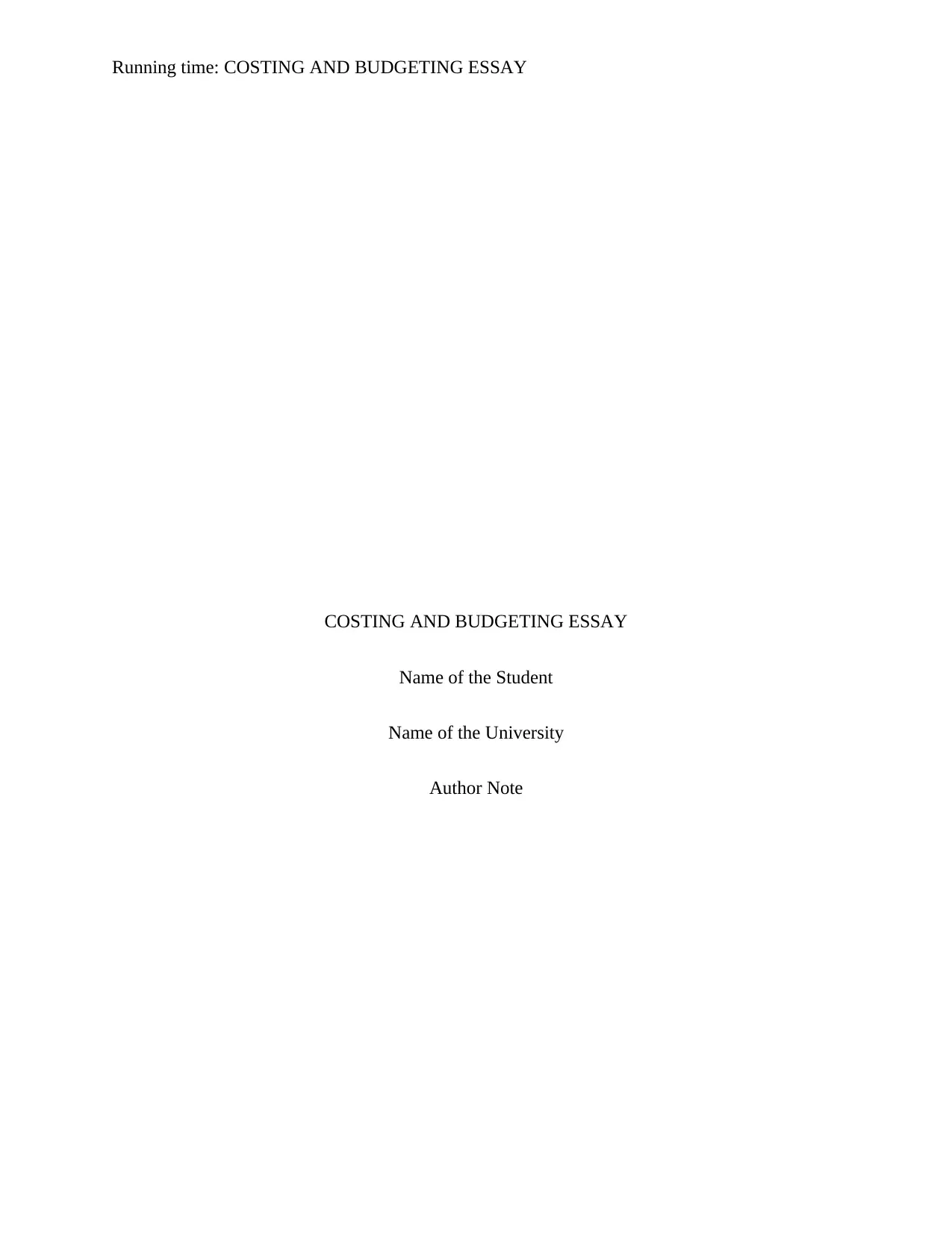
Running time: COSTING AND BUDGETING ESSAY
COSTING AND BUDGETING ESSAY
Name of the Student
Name of the University
Author Note
COSTING AND BUDGETING ESSAY
Name of the Student
Name of the University
Author Note
Secure Best Marks with AI Grader
Need help grading? Try our AI Grader for instant feedback on your assignments.
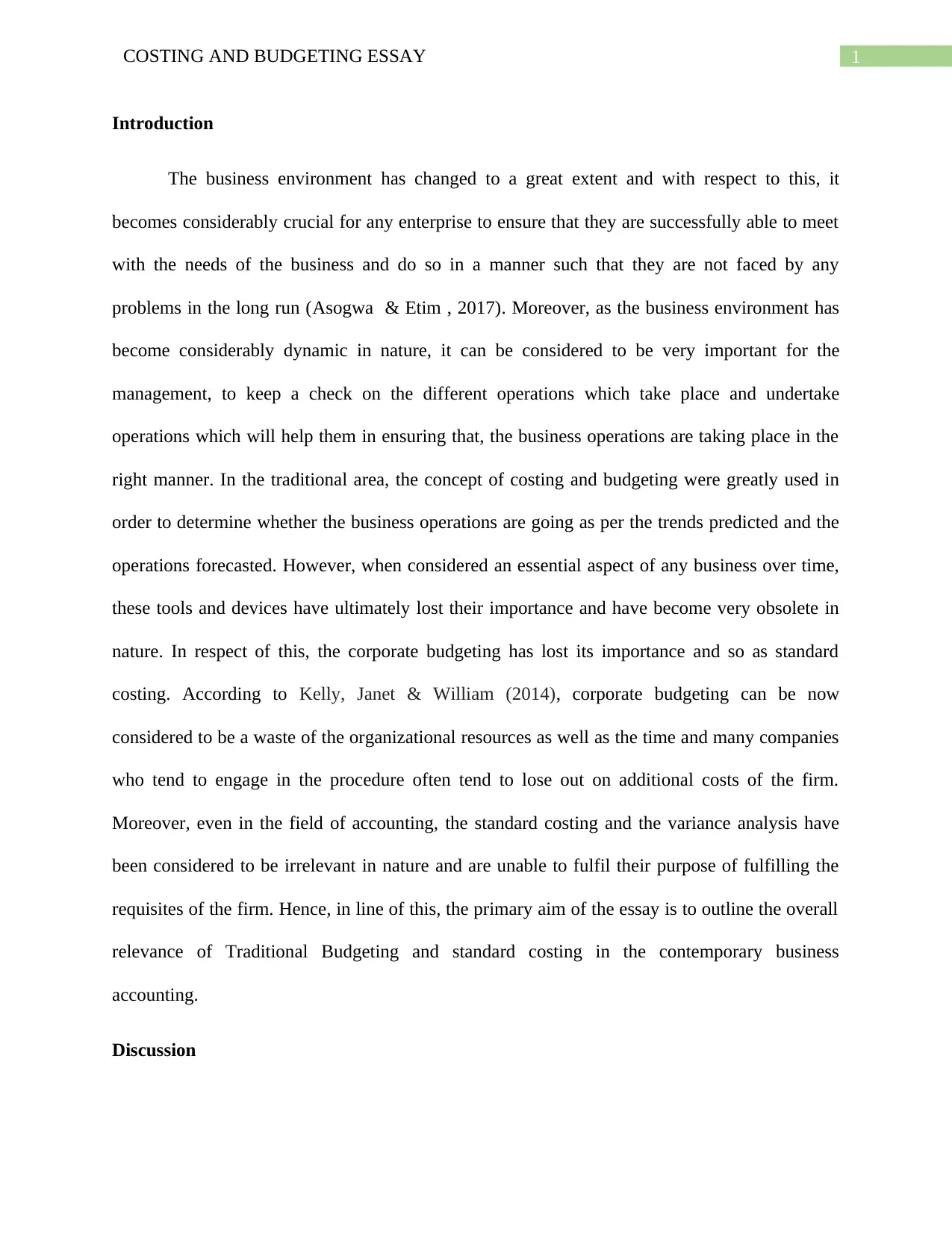
1COSTING AND BUDGETING ESSAY
Introduction
The business environment has changed to a great extent and with respect to this, it
becomes considerably crucial for any enterprise to ensure that they are successfully able to meet
with the needs of the business and do so in a manner such that they are not faced by any
problems in the long run (Asogwa & Etim , 2017). Moreover, as the business environment has
become considerably dynamic in nature, it can be considered to be very important for the
management, to keep a check on the different operations which take place and undertake
operations which will help them in ensuring that, the business operations are taking place in the
right manner. In the traditional area, the concept of costing and budgeting were greatly used in
order to determine whether the business operations are going as per the trends predicted and the
operations forecasted. However, when considered an essential aspect of any business over time,
these tools and devices have ultimately lost their importance and have become very obsolete in
nature. In respect of this, the corporate budgeting has lost its importance and so as standard
costing. According to Kelly, Janet & William (2014), corporate budgeting can be now
considered to be a waste of the organizational resources as well as the time and many companies
who tend to engage in the procedure often tend to lose out on additional costs of the firm.
Moreover, even in the field of accounting, the standard costing and the variance analysis have
been considered to be irrelevant in nature and are unable to fulfil their purpose of fulfilling the
requisites of the firm. Hence, in line of this, the primary aim of the essay is to outline the overall
relevance of Traditional Budgeting and standard costing in the contemporary business
accounting.
Discussion
Introduction
The business environment has changed to a great extent and with respect to this, it
becomes considerably crucial for any enterprise to ensure that they are successfully able to meet
with the needs of the business and do so in a manner such that they are not faced by any
problems in the long run (Asogwa & Etim , 2017). Moreover, as the business environment has
become considerably dynamic in nature, it can be considered to be very important for the
management, to keep a check on the different operations which take place and undertake
operations which will help them in ensuring that, the business operations are taking place in the
right manner. In the traditional area, the concept of costing and budgeting were greatly used in
order to determine whether the business operations are going as per the trends predicted and the
operations forecasted. However, when considered an essential aspect of any business over time,
these tools and devices have ultimately lost their importance and have become very obsolete in
nature. In respect of this, the corporate budgeting has lost its importance and so as standard
costing. According to Kelly, Janet & William (2014), corporate budgeting can be now
considered to be a waste of the organizational resources as well as the time and many companies
who tend to engage in the procedure often tend to lose out on additional costs of the firm.
Moreover, even in the field of accounting, the standard costing and the variance analysis have
been considered to be irrelevant in nature and are unable to fulfil their purpose of fulfilling the
requisites of the firm. Hence, in line of this, the primary aim of the essay is to outline the overall
relevance of Traditional Budgeting and standard costing in the contemporary business
accounting.
Discussion
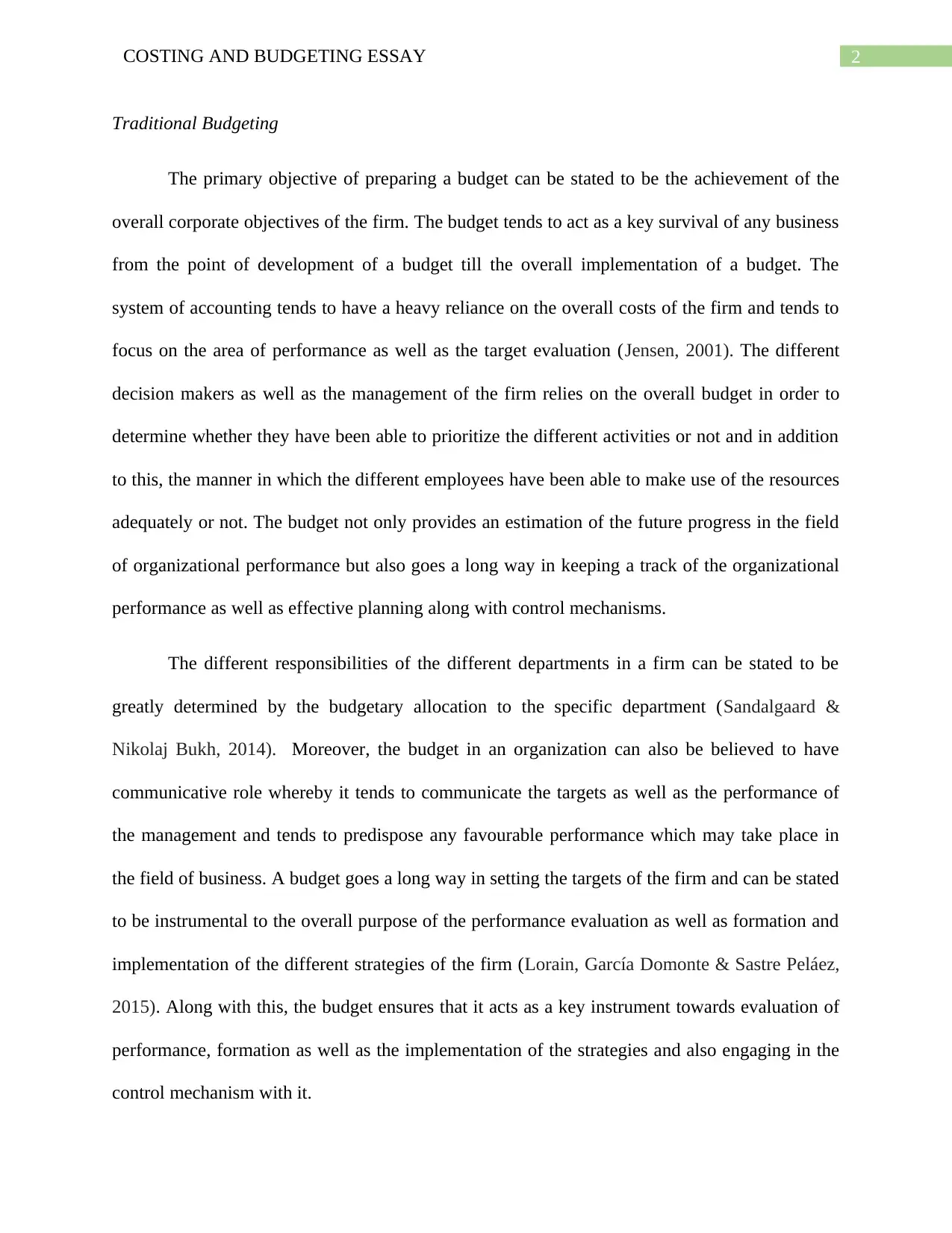
2COSTING AND BUDGETING ESSAY
Traditional Budgeting
The primary objective of preparing a budget can be stated to be the achievement of the
overall corporate objectives of the firm. The budget tends to act as a key survival of any business
from the point of development of a budget till the overall implementation of a budget. The
system of accounting tends to have a heavy reliance on the overall costs of the firm and tends to
focus on the area of performance as well as the target evaluation (Jensen, 2001). The different
decision makers as well as the management of the firm relies on the overall budget in order to
determine whether they have been able to prioritize the different activities or not and in addition
to this, the manner in which the different employees have been able to make use of the resources
adequately or not. The budget not only provides an estimation of the future progress in the field
of organizational performance but also goes a long way in keeping a track of the organizational
performance as well as effective planning along with control mechanisms.
The different responsibilities of the different departments in a firm can be stated to be
greatly determined by the budgetary allocation to the specific department (Sandalgaard &
Nikolaj Bukh, 2014). Moreover, the budget in an organization can also be believed to have
communicative role whereby it tends to communicate the targets as well as the performance of
the management and tends to predispose any favourable performance which may take place in
the field of business. A budget goes a long way in setting the targets of the firm and can be stated
to be instrumental to the overall purpose of the performance evaluation as well as formation and
implementation of the different strategies of the firm (Lorain, García Domonte & Sastre Peláez,
2015). Along with this, the budget ensures that it acts as a key instrument towards evaluation of
performance, formation as well as the implementation of the strategies and also engaging in the
control mechanism with it.
Traditional Budgeting
The primary objective of preparing a budget can be stated to be the achievement of the
overall corporate objectives of the firm. The budget tends to act as a key survival of any business
from the point of development of a budget till the overall implementation of a budget. The
system of accounting tends to have a heavy reliance on the overall costs of the firm and tends to
focus on the area of performance as well as the target evaluation (Jensen, 2001). The different
decision makers as well as the management of the firm relies on the overall budget in order to
determine whether they have been able to prioritize the different activities or not and in addition
to this, the manner in which the different employees have been able to make use of the resources
adequately or not. The budget not only provides an estimation of the future progress in the field
of organizational performance but also goes a long way in keeping a track of the organizational
performance as well as effective planning along with control mechanisms.
The different responsibilities of the different departments in a firm can be stated to be
greatly determined by the budgetary allocation to the specific department (Sandalgaard &
Nikolaj Bukh, 2014). Moreover, the budget in an organization can also be believed to have
communicative role whereby it tends to communicate the targets as well as the performance of
the management and tends to predispose any favourable performance which may take place in
the field of business. A budget goes a long way in setting the targets of the firm and can be stated
to be instrumental to the overall purpose of the performance evaluation as well as formation and
implementation of the different strategies of the firm (Lorain, García Domonte & Sastre Peláez,
2015). Along with this, the budget ensures that it acts as a key instrument towards evaluation of
performance, formation as well as the implementation of the strategies and also engaging in the
control mechanism with it.
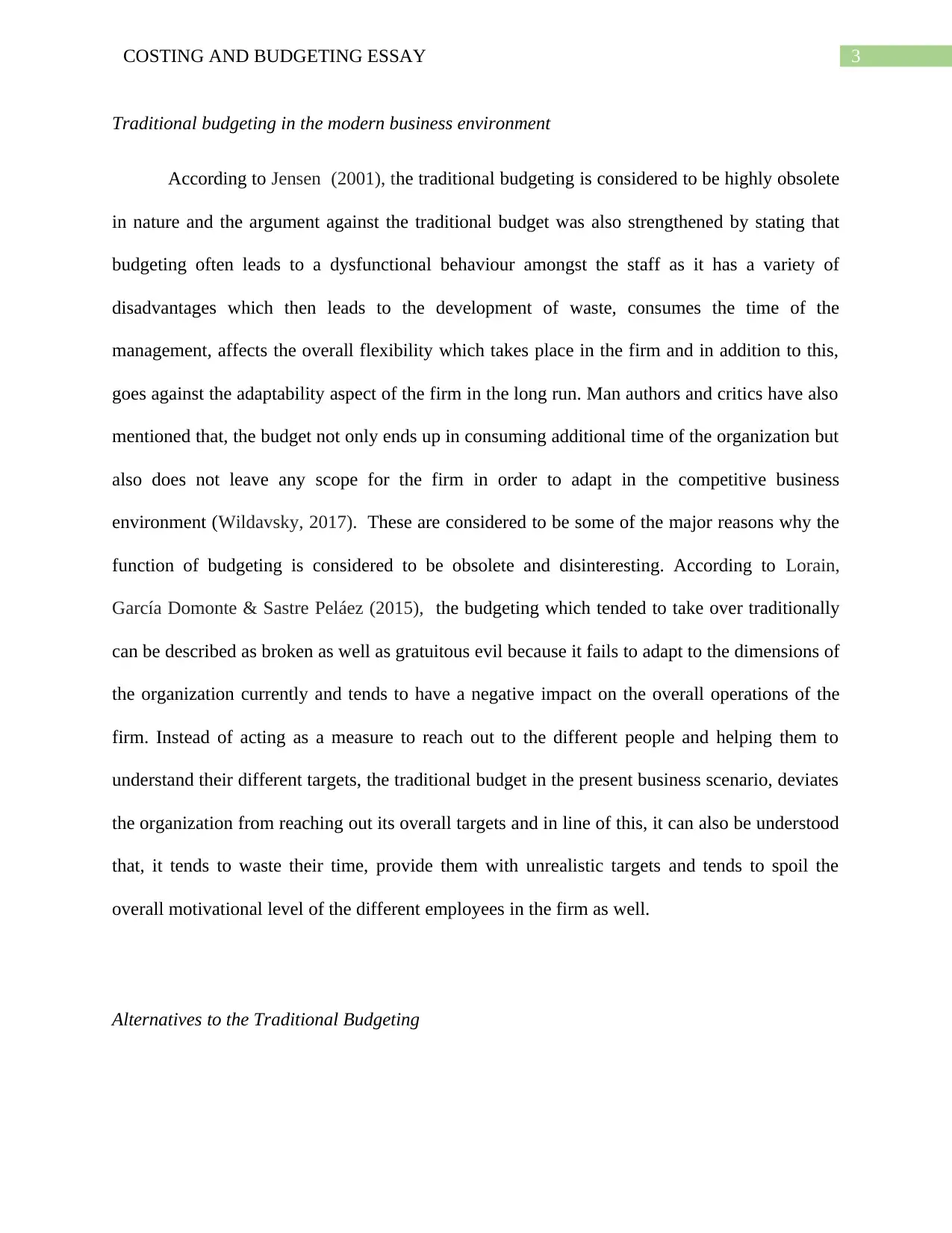
3COSTING AND BUDGETING ESSAY
Traditional budgeting in the modern business environment
According to Jensen (2001), the traditional budgeting is considered to be highly obsolete
in nature and the argument against the traditional budget was also strengthened by stating that
budgeting often leads to a dysfunctional behaviour amongst the staff as it has a variety of
disadvantages which then leads to the development of waste, consumes the time of the
management, affects the overall flexibility which takes place in the firm and in addition to this,
goes against the adaptability aspect of the firm in the long run. Man authors and critics have also
mentioned that, the budget not only ends up in consuming additional time of the organization but
also does not leave any scope for the firm in order to adapt in the competitive business
environment (Wildavsky, 2017). These are considered to be some of the major reasons why the
function of budgeting is considered to be obsolete and disinteresting. According to Lorain,
García Domonte & Sastre Peláez (2015), the budgeting which tended to take over traditionally
can be described as broken as well as gratuitous evil because it fails to adapt to the dimensions of
the organization currently and tends to have a negative impact on the overall operations of the
firm. Instead of acting as a measure to reach out to the different people and helping them to
understand their different targets, the traditional budget in the present business scenario, deviates
the organization from reaching out its overall targets and in line of this, it can also be understood
that, it tends to waste their time, provide them with unrealistic targets and tends to spoil the
overall motivational level of the different employees in the firm as well.
Alternatives to the Traditional Budgeting
Traditional budgeting in the modern business environment
According to Jensen (2001), the traditional budgeting is considered to be highly obsolete
in nature and the argument against the traditional budget was also strengthened by stating that
budgeting often leads to a dysfunctional behaviour amongst the staff as it has a variety of
disadvantages which then leads to the development of waste, consumes the time of the
management, affects the overall flexibility which takes place in the firm and in addition to this,
goes against the adaptability aspect of the firm in the long run. Man authors and critics have also
mentioned that, the budget not only ends up in consuming additional time of the organization but
also does not leave any scope for the firm in order to adapt in the competitive business
environment (Wildavsky, 2017). These are considered to be some of the major reasons why the
function of budgeting is considered to be obsolete and disinteresting. According to Lorain,
García Domonte & Sastre Peláez (2015), the budgeting which tended to take over traditionally
can be described as broken as well as gratuitous evil because it fails to adapt to the dimensions of
the organization currently and tends to have a negative impact on the overall operations of the
firm. Instead of acting as a measure to reach out to the different people and helping them to
understand their different targets, the traditional budget in the present business scenario, deviates
the organization from reaching out its overall targets and in line of this, it can also be understood
that, it tends to waste their time, provide them with unrealistic targets and tends to spoil the
overall motivational level of the different employees in the firm as well.
Alternatives to the Traditional Budgeting
Secure Best Marks with AI Grader
Need help grading? Try our AI Grader for instant feedback on your assignments.
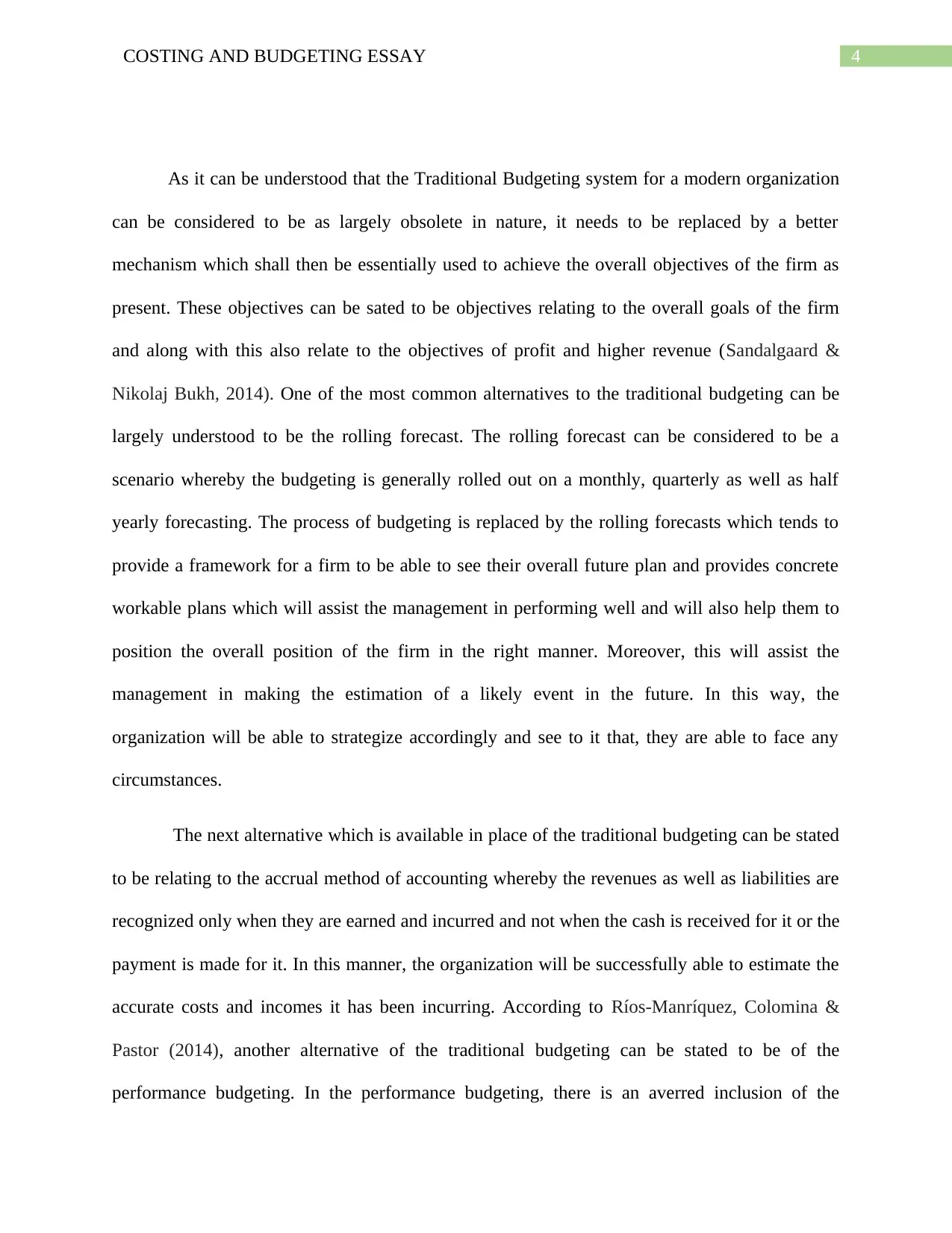
4COSTING AND BUDGETING ESSAY
As it can be understood that the Traditional Budgeting system for a modern organization
can be considered to be as largely obsolete in nature, it needs to be replaced by a better
mechanism which shall then be essentially used to achieve the overall objectives of the firm as
present. These objectives can be sated to be objectives relating to the overall goals of the firm
and along with this also relate to the objectives of profit and higher revenue (Sandalgaard &
Nikolaj Bukh, 2014). One of the most common alternatives to the traditional budgeting can be
largely understood to be the rolling forecast. The rolling forecast can be considered to be a
scenario whereby the budgeting is generally rolled out on a monthly, quarterly as well as half
yearly forecasting. The process of budgeting is replaced by the rolling forecasts which tends to
provide a framework for a firm to be able to see their overall future plan and provides concrete
workable plans which will assist the management in performing well and will also help them to
position the overall position of the firm in the right manner. Moreover, this will assist the
management in making the estimation of a likely event in the future. In this way, the
organization will be able to strategize accordingly and see to it that, they are able to face any
circumstances.
The next alternative which is available in place of the traditional budgeting can be stated
to be relating to the accrual method of accounting whereby the revenues as well as liabilities are
recognized only when they are earned and incurred and not when the cash is received for it or the
payment is made for it. In this manner, the organization will be successfully able to estimate the
accurate costs and incomes it has been incurring. According to Ríos-Manríquez, Colomina &
Pastor (2014), another alternative of the traditional budgeting can be stated to be of the
performance budgeting. In the performance budgeting, there is an averred inclusion of the
As it can be understood that the Traditional Budgeting system for a modern organization
can be considered to be as largely obsolete in nature, it needs to be replaced by a better
mechanism which shall then be essentially used to achieve the overall objectives of the firm as
present. These objectives can be sated to be objectives relating to the overall goals of the firm
and along with this also relate to the objectives of profit and higher revenue (Sandalgaard &
Nikolaj Bukh, 2014). One of the most common alternatives to the traditional budgeting can be
largely understood to be the rolling forecast. The rolling forecast can be considered to be a
scenario whereby the budgeting is generally rolled out on a monthly, quarterly as well as half
yearly forecasting. The process of budgeting is replaced by the rolling forecasts which tends to
provide a framework for a firm to be able to see their overall future plan and provides concrete
workable plans which will assist the management in performing well and will also help them to
position the overall position of the firm in the right manner. Moreover, this will assist the
management in making the estimation of a likely event in the future. In this way, the
organization will be able to strategize accordingly and see to it that, they are able to face any
circumstances.
The next alternative which is available in place of the traditional budgeting can be stated
to be relating to the accrual method of accounting whereby the revenues as well as liabilities are
recognized only when they are earned and incurred and not when the cash is received for it or the
payment is made for it. In this manner, the organization will be successfully able to estimate the
accurate costs and incomes it has been incurring. According to Ríos-Manríquez, Colomina &
Pastor (2014), another alternative of the traditional budgeting can be stated to be of the
performance budgeting. In the performance budgeting, there is an averred inclusion of the
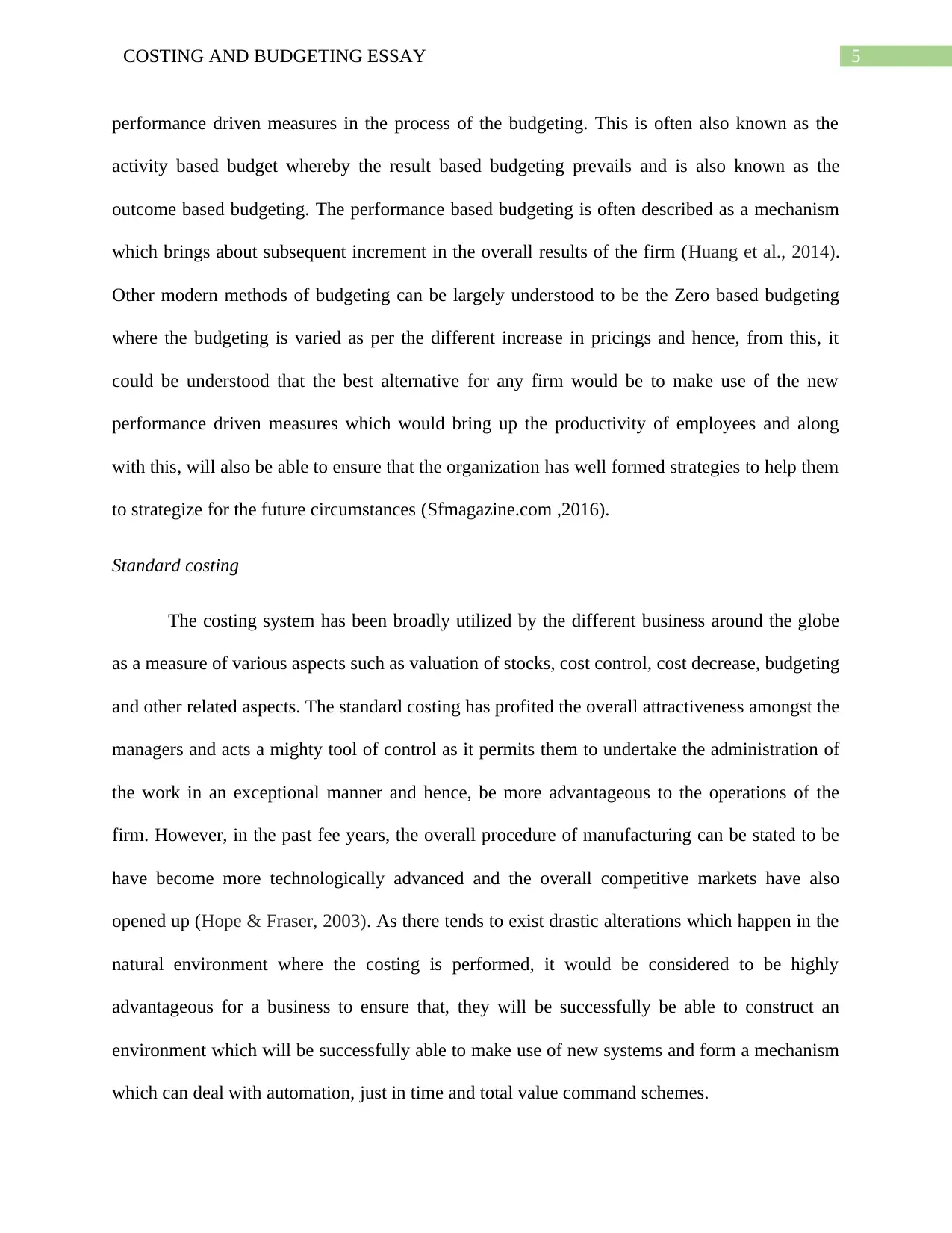
5COSTING AND BUDGETING ESSAY
performance driven measures in the process of the budgeting. This is often also known as the
activity based budget whereby the result based budgeting prevails and is also known as the
outcome based budgeting. The performance based budgeting is often described as a mechanism
which brings about subsequent increment in the overall results of the firm (Huang et al., 2014).
Other modern methods of budgeting can be largely understood to be the Zero based budgeting
where the budgeting is varied as per the different increase in pricings and hence, from this, it
could be understood that the best alternative for any firm would be to make use of the new
performance driven measures which would bring up the productivity of employees and along
with this, will also be able to ensure that the organization has well formed strategies to help them
to strategize for the future circumstances (Sfmagazine.com ,2016).
Standard costing
The costing system has been broadly utilized by the different business around the globe
as a measure of various aspects such as valuation of stocks, cost control, cost decrease, budgeting
and other related aspects. The standard costing has profited the overall attractiveness amongst the
managers and acts a mighty tool of control as it permits them to undertake the administration of
the work in an exceptional manner and hence, be more advantageous to the operations of the
firm. However, in the past fee years, the overall procedure of manufacturing can be stated to be
have become more technologically advanced and the overall competitive markets have also
opened up (Hope & Fraser, 2003). As there tends to exist drastic alterations which happen in the
natural environment where the costing is performed, it would be considered to be highly
advantageous for a business to ensure that, they will be successfully be able to construct an
environment which will be successfully able to make use of new systems and form a mechanism
which can deal with automation, just in time and total value command schemes.
performance driven measures in the process of the budgeting. This is often also known as the
activity based budget whereby the result based budgeting prevails and is also known as the
outcome based budgeting. The performance based budgeting is often described as a mechanism
which brings about subsequent increment in the overall results of the firm (Huang et al., 2014).
Other modern methods of budgeting can be largely understood to be the Zero based budgeting
where the budgeting is varied as per the different increase in pricings and hence, from this, it
could be understood that the best alternative for any firm would be to make use of the new
performance driven measures which would bring up the productivity of employees and along
with this, will also be able to ensure that the organization has well formed strategies to help them
to strategize for the future circumstances (Sfmagazine.com ,2016).
Standard costing
The costing system has been broadly utilized by the different business around the globe
as a measure of various aspects such as valuation of stocks, cost control, cost decrease, budgeting
and other related aspects. The standard costing has profited the overall attractiveness amongst the
managers and acts a mighty tool of control as it permits them to undertake the administration of
the work in an exceptional manner and hence, be more advantageous to the operations of the
firm. However, in the past fee years, the overall procedure of manufacturing can be stated to be
have become more technologically advanced and the overall competitive markets have also
opened up (Hope & Fraser, 2003). As there tends to exist drastic alterations which happen in the
natural environment where the costing is performed, it would be considered to be highly
advantageous for a business to ensure that, they will be successfully be able to construct an
environment which will be successfully able to make use of new systems and form a mechanism
which can deal with automation, just in time and total value command schemes.
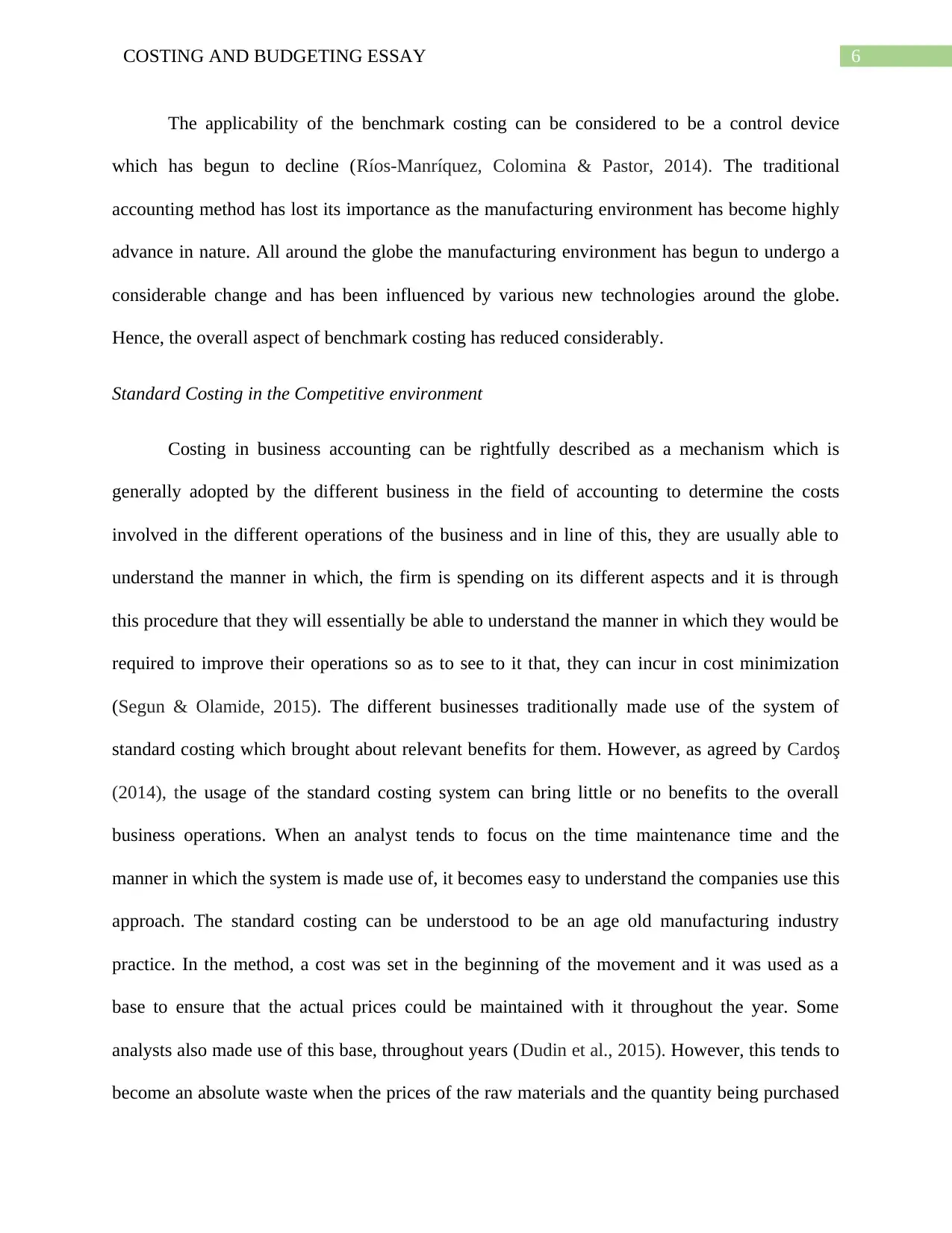
6COSTING AND BUDGETING ESSAY
The applicability of the benchmark costing can be considered to be a control device
which has begun to decline (Ríos-Manríquez, Colomina & Pastor, 2014). The traditional
accounting method has lost its importance as the manufacturing environment has become highly
advance in nature. All around the globe the manufacturing environment has begun to undergo a
considerable change and has been influenced by various new technologies around the globe.
Hence, the overall aspect of benchmark costing has reduced considerably.
Standard Costing in the Competitive environment
Costing in business accounting can be rightfully described as a mechanism which is
generally adopted by the different business in the field of accounting to determine the costs
involved in the different operations of the business and in line of this, they are usually able to
understand the manner in which, the firm is spending on its different aspects and it is through
this procedure that they will essentially be able to understand the manner in which they would be
required to improve their operations so as to see to it that, they can incur in cost minimization
(Segun & Olamide, 2015). The different businesses traditionally made use of the system of
standard costing which brought about relevant benefits for them. However, as agreed by Cardoş
(2014), the usage of the standard costing system can bring little or no benefits to the overall
business operations. When an analyst tends to focus on the time maintenance time and the
manner in which the system is made use of, it becomes easy to understand the companies use this
approach. The standard costing can be understood to be an age old manufacturing industry
practice. In the method, a cost was set in the beginning of the movement and it was used as a
base to ensure that the actual prices could be maintained with it throughout the year. Some
analysts also made use of this base, throughout years (Dudin et al., 2015). However, this tends to
become an absolute waste when the prices of the raw materials and the quantity being purchased
The applicability of the benchmark costing can be considered to be a control device
which has begun to decline (Ríos-Manríquez, Colomina & Pastor, 2014). The traditional
accounting method has lost its importance as the manufacturing environment has become highly
advance in nature. All around the globe the manufacturing environment has begun to undergo a
considerable change and has been influenced by various new technologies around the globe.
Hence, the overall aspect of benchmark costing has reduced considerably.
Standard Costing in the Competitive environment
Costing in business accounting can be rightfully described as a mechanism which is
generally adopted by the different business in the field of accounting to determine the costs
involved in the different operations of the business and in line of this, they are usually able to
understand the manner in which, the firm is spending on its different aspects and it is through
this procedure that they will essentially be able to understand the manner in which they would be
required to improve their operations so as to see to it that, they can incur in cost minimization
(Segun & Olamide, 2015). The different businesses traditionally made use of the system of
standard costing which brought about relevant benefits for them. However, as agreed by Cardoş
(2014), the usage of the standard costing system can bring little or no benefits to the overall
business operations. When an analyst tends to focus on the time maintenance time and the
manner in which the system is made use of, it becomes easy to understand the companies use this
approach. The standard costing can be understood to be an age old manufacturing industry
practice. In the method, a cost was set in the beginning of the movement and it was used as a
base to ensure that the actual prices could be maintained with it throughout the year. Some
analysts also made use of this base, throughout years (Dudin et al., 2015). However, this tends to
become an absolute waste when the prices of the raw materials and the quantity being purchased
Paraphrase This Document
Need a fresh take? Get an instant paraphrase of this document with our AI Paraphraser
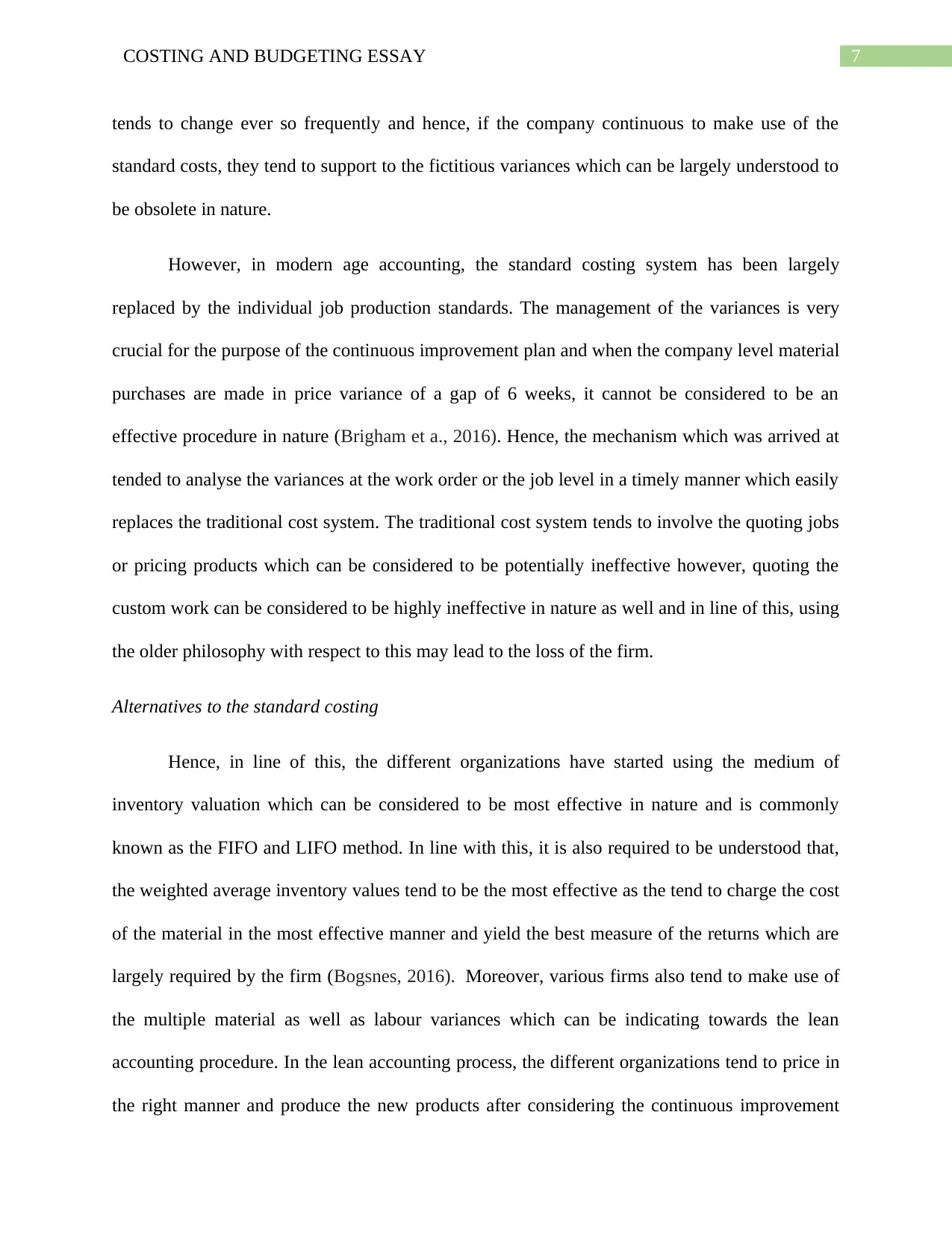
7COSTING AND BUDGETING ESSAY
tends to change ever so frequently and hence, if the company continuous to make use of the
standard costs, they tend to support to the fictitious variances which can be largely understood to
be obsolete in nature.
However, in modern age accounting, the standard costing system has been largely
replaced by the individual job production standards. The management of the variances is very
crucial for the purpose of the continuous improvement plan and when the company level material
purchases are made in price variance of a gap of 6 weeks, it cannot be considered to be an
effective procedure in nature (Brigham et a., 2016). Hence, the mechanism which was arrived at
tended to analyse the variances at the work order or the job level in a timely manner which easily
replaces the traditional cost system. The traditional cost system tends to involve the quoting jobs
or pricing products which can be considered to be potentially ineffective however, quoting the
custom work can be considered to be highly ineffective in nature as well and in line of this, using
the older philosophy with respect to this may lead to the loss of the firm.
Alternatives to the standard costing
Hence, in line of this, the different organizations have started using the medium of
inventory valuation which can be considered to be most effective in nature and is commonly
known as the FIFO and LIFO method. In line with this, it is also required to be understood that,
the weighted average inventory values tend to be the most effective as the tend to charge the cost
of the material in the most effective manner and yield the best measure of the returns which are
largely required by the firm (Bogsnes, 2016). Moreover, various firms also tend to make use of
the multiple material as well as labour variances which can be indicating towards the lean
accounting procedure. In the lean accounting process, the different organizations tend to price in
the right manner and produce the new products after considering the continuous improvement
tends to change ever so frequently and hence, if the company continuous to make use of the
standard costs, they tend to support to the fictitious variances which can be largely understood to
be obsolete in nature.
However, in modern age accounting, the standard costing system has been largely
replaced by the individual job production standards. The management of the variances is very
crucial for the purpose of the continuous improvement plan and when the company level material
purchases are made in price variance of a gap of 6 weeks, it cannot be considered to be an
effective procedure in nature (Brigham et a., 2016). Hence, the mechanism which was arrived at
tended to analyse the variances at the work order or the job level in a timely manner which easily
replaces the traditional cost system. The traditional cost system tends to involve the quoting jobs
or pricing products which can be considered to be potentially ineffective however, quoting the
custom work can be considered to be highly ineffective in nature as well and in line of this, using
the older philosophy with respect to this may lead to the loss of the firm.
Alternatives to the standard costing
Hence, in line of this, the different organizations have started using the medium of
inventory valuation which can be considered to be most effective in nature and is commonly
known as the FIFO and LIFO method. In line with this, it is also required to be understood that,
the weighted average inventory values tend to be the most effective as the tend to charge the cost
of the material in the most effective manner and yield the best measure of the returns which are
largely required by the firm (Bogsnes, 2016). Moreover, various firms also tend to make use of
the multiple material as well as labour variances which can be indicating towards the lean
accounting procedure. In the lean accounting process, the different organizations tend to price in
the right manner and produce the new products after considering the continuous improvement
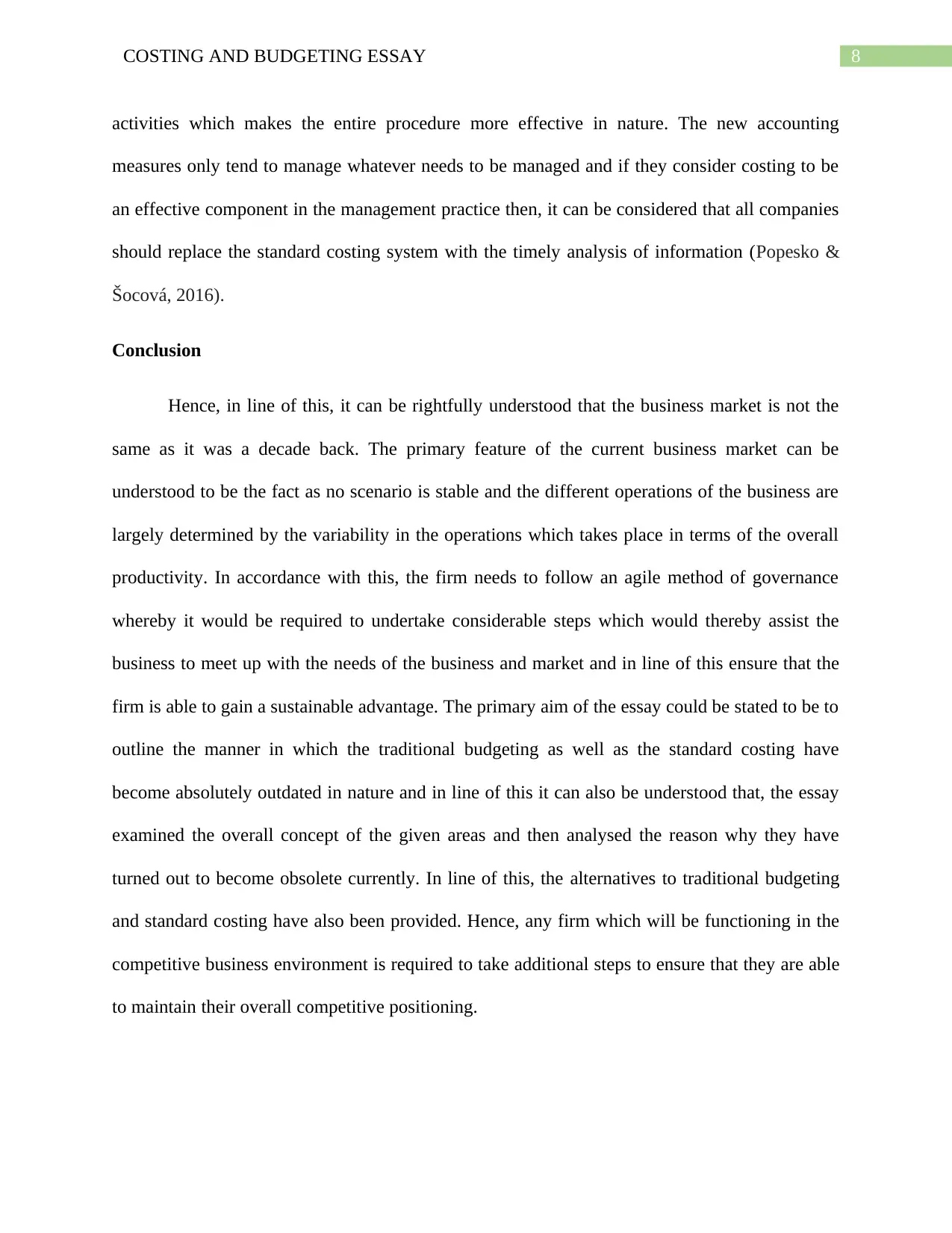
8COSTING AND BUDGETING ESSAY
activities which makes the entire procedure more effective in nature. The new accounting
measures only tend to manage whatever needs to be managed and if they consider costing to be
an effective component in the management practice then, it can be considered that all companies
should replace the standard costing system with the timely analysis of information (Popesko &
Šocová, 2016).
Conclusion
Hence, in line of this, it can be rightfully understood that the business market is not the
same as it was a decade back. The primary feature of the current business market can be
understood to be the fact as no scenario is stable and the different operations of the business are
largely determined by the variability in the operations which takes place in terms of the overall
productivity. In accordance with this, the firm needs to follow an agile method of governance
whereby it would be required to undertake considerable steps which would thereby assist the
business to meet up with the needs of the business and market and in line of this ensure that the
firm is able to gain a sustainable advantage. The primary aim of the essay could be stated to be to
outline the manner in which the traditional budgeting as well as the standard costing have
become absolutely outdated in nature and in line of this it can also be understood that, the essay
examined the overall concept of the given areas and then analysed the reason why they have
turned out to become obsolete currently. In line of this, the alternatives to traditional budgeting
and standard costing have also been provided. Hence, any firm which will be functioning in the
competitive business environment is required to take additional steps to ensure that they are able
to maintain their overall competitive positioning.
activities which makes the entire procedure more effective in nature. The new accounting
measures only tend to manage whatever needs to be managed and if they consider costing to be
an effective component in the management practice then, it can be considered that all companies
should replace the standard costing system with the timely analysis of information (Popesko &
Šocová, 2016).
Conclusion
Hence, in line of this, it can be rightfully understood that the business market is not the
same as it was a decade back. The primary feature of the current business market can be
understood to be the fact as no scenario is stable and the different operations of the business are
largely determined by the variability in the operations which takes place in terms of the overall
productivity. In accordance with this, the firm needs to follow an agile method of governance
whereby it would be required to undertake considerable steps which would thereby assist the
business to meet up with the needs of the business and market and in line of this ensure that the
firm is able to gain a sustainable advantage. The primary aim of the essay could be stated to be to
outline the manner in which the traditional budgeting as well as the standard costing have
become absolutely outdated in nature and in line of this it can also be understood that, the essay
examined the overall concept of the given areas and then analysed the reason why they have
turned out to become obsolete currently. In line of this, the alternatives to traditional budgeting
and standard costing have also been provided. Hence, any firm which will be functioning in the
competitive business environment is required to take additional steps to ensure that they are able
to maintain their overall competitive positioning.
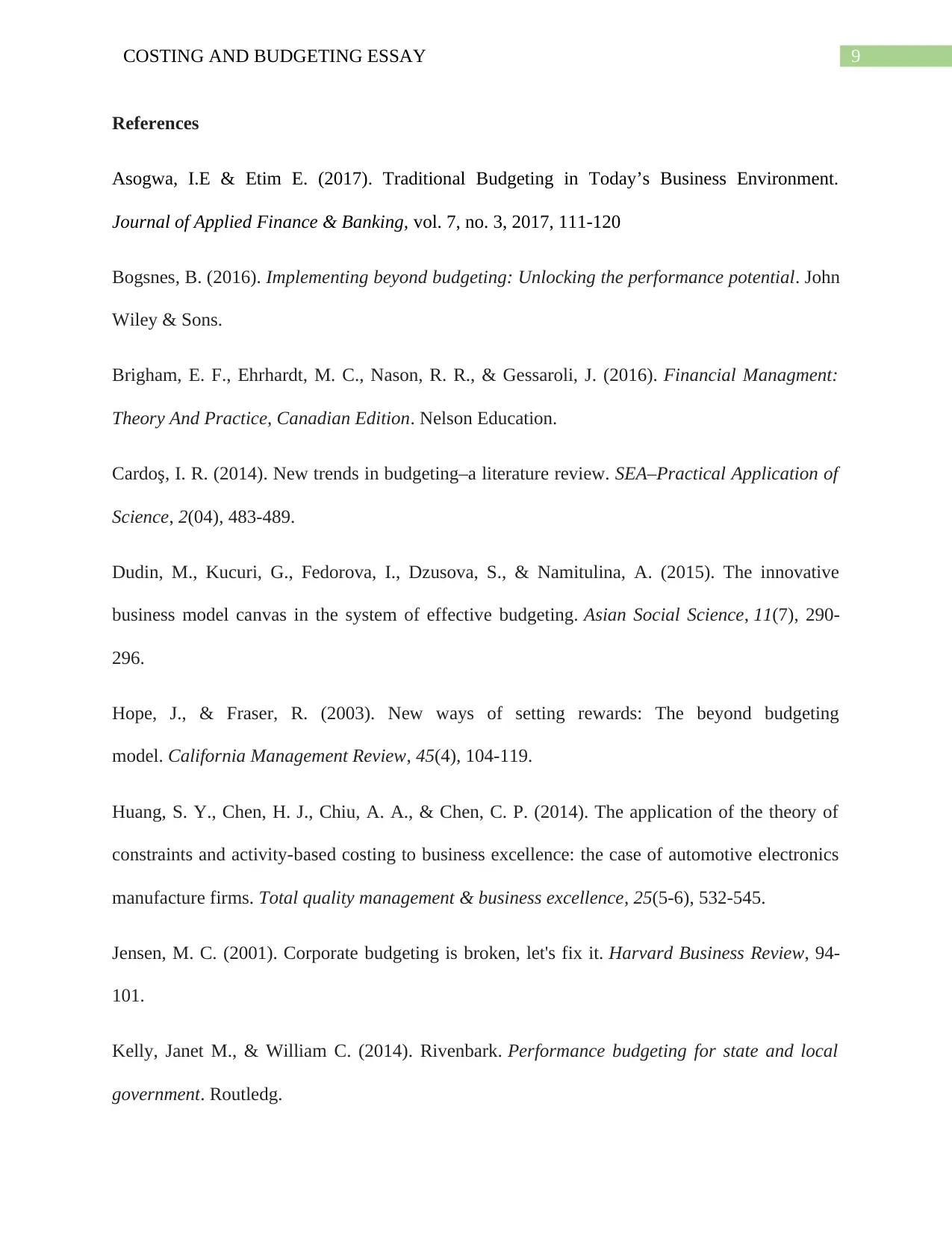
9COSTING AND BUDGETING ESSAY
References
Asogwa, I.E & Etim E. (2017). Traditional Budgeting in Today’s Business Environment.
Journal of Applied Finance & Banking, vol. 7, no. 3, 2017, 111-120
Bogsnes, B. (2016). Implementing beyond budgeting: Unlocking the performance potential. John
Wiley & Sons.
Brigham, E. F., Ehrhardt, M. C., Nason, R. R., & Gessaroli, J. (2016). Financial Managment:
Theory And Practice, Canadian Edition. Nelson Education.
Cardoş, I. R. (2014). New trends in budgeting–a literature review. SEA–Practical Application of
Science, 2(04), 483-489.
Dudin, M., Kucuri, G., Fedorova, I., Dzusova, S., & Namitulina, A. (2015). The innovative
business model canvas in the system of effective budgeting. Asian Social Science, 11(7), 290-
296.
Hope, J., & Fraser, R. (2003). New ways of setting rewards: The beyond budgeting
model. California Management Review, 45(4), 104-119.
Huang, S. Y., Chen, H. J., Chiu, A. A., & Chen, C. P. (2014). The application of the theory of
constraints and activity-based costing to business excellence: the case of automotive electronics
manufacture firms. Total quality management & business excellence, 25(5-6), 532-545.
Jensen, M. C. (2001). Corporate budgeting is broken, let's fix it. Harvard Business Review, 94-
101.
Kelly, Janet M., & William C. (2014). Rivenbark. Performance budgeting for state and local
government. Routledg.
References
Asogwa, I.E & Etim E. (2017). Traditional Budgeting in Today’s Business Environment.
Journal of Applied Finance & Banking, vol. 7, no. 3, 2017, 111-120
Bogsnes, B. (2016). Implementing beyond budgeting: Unlocking the performance potential. John
Wiley & Sons.
Brigham, E. F., Ehrhardt, M. C., Nason, R. R., & Gessaroli, J. (2016). Financial Managment:
Theory And Practice, Canadian Edition. Nelson Education.
Cardoş, I. R. (2014). New trends in budgeting–a literature review. SEA–Practical Application of
Science, 2(04), 483-489.
Dudin, M., Kucuri, G., Fedorova, I., Dzusova, S., & Namitulina, A. (2015). The innovative
business model canvas in the system of effective budgeting. Asian Social Science, 11(7), 290-
296.
Hope, J., & Fraser, R. (2003). New ways of setting rewards: The beyond budgeting
model. California Management Review, 45(4), 104-119.
Huang, S. Y., Chen, H. J., Chiu, A. A., & Chen, C. P. (2014). The application of the theory of
constraints and activity-based costing to business excellence: the case of automotive electronics
manufacture firms. Total quality management & business excellence, 25(5-6), 532-545.
Jensen, M. C. (2001). Corporate budgeting is broken, let's fix it. Harvard Business Review, 94-
101.
Kelly, Janet M., & William C. (2014). Rivenbark. Performance budgeting for state and local
government. Routledg.
Secure Best Marks with AI Grader
Need help grading? Try our AI Grader for instant feedback on your assignments.
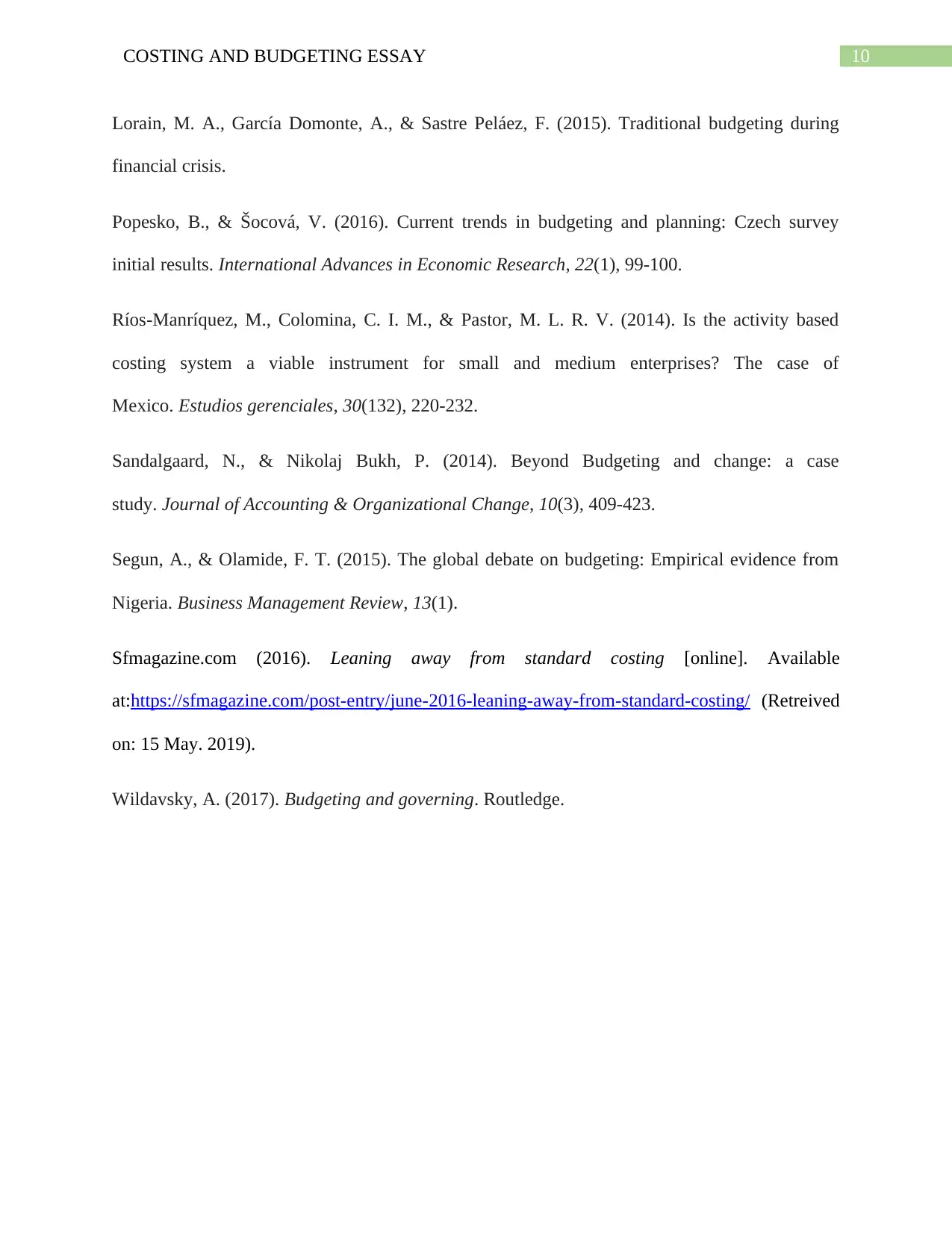
10COSTING AND BUDGETING ESSAY
Lorain, M. A., García Domonte, A., & Sastre Peláez, F. (2015). Traditional budgeting during
financial crisis.
Popesko, B., & Šocová, V. (2016). Current trends in budgeting and planning: Czech survey
initial results. International Advances in Economic Research, 22(1), 99-100.
Ríos-Manríquez, M., Colomina, C. I. M., & Pastor, M. L. R. V. (2014). Is the activity based
costing system a viable instrument for small and medium enterprises? The case of
Mexico. Estudios gerenciales, 30(132), 220-232.
Sandalgaard, N., & Nikolaj Bukh, P. (2014). Beyond Budgeting and change: a case
study. Journal of Accounting & Organizational Change, 10(3), 409-423.
Segun, A., & Olamide, F. T. (2015). The global debate on budgeting: Empirical evidence from
Nigeria. Business Management Review, 13(1).
Sfmagazine.com (2016). Leaning away from standard costing [online]. Available
at:https://sfmagazine.com/post-entry/june-2016-leaning-away-from-standard-costing/ (Retreived
on: 15 May. 2019).
Wildavsky, A. (2017). Budgeting and governing. Routledge.
Lorain, M. A., García Domonte, A., & Sastre Peláez, F. (2015). Traditional budgeting during
financial crisis.
Popesko, B., & Šocová, V. (2016). Current trends in budgeting and planning: Czech survey
initial results. International Advances in Economic Research, 22(1), 99-100.
Ríos-Manríquez, M., Colomina, C. I. M., & Pastor, M. L. R. V. (2014). Is the activity based
costing system a viable instrument for small and medium enterprises? The case of
Mexico. Estudios gerenciales, 30(132), 220-232.
Sandalgaard, N., & Nikolaj Bukh, P. (2014). Beyond Budgeting and change: a case
study. Journal of Accounting & Organizational Change, 10(3), 409-423.
Segun, A., & Olamide, F. T. (2015). The global debate on budgeting: Empirical evidence from
Nigeria. Business Management Review, 13(1).
Sfmagazine.com (2016). Leaning away from standard costing [online]. Available
at:https://sfmagazine.com/post-entry/june-2016-leaning-away-from-standard-costing/ (Retreived
on: 15 May. 2019).
Wildavsky, A. (2017). Budgeting and governing. Routledge.
1 out of 11
Related Documents
Your All-in-One AI-Powered Toolkit for Academic Success.
+13062052269
info@desklib.com
Available 24*7 on WhatsApp / Email
![[object Object]](/_next/static/media/star-bottom.7253800d.svg)
Unlock your academic potential
© 2024 | Zucol Services PVT LTD | All rights reserved.





